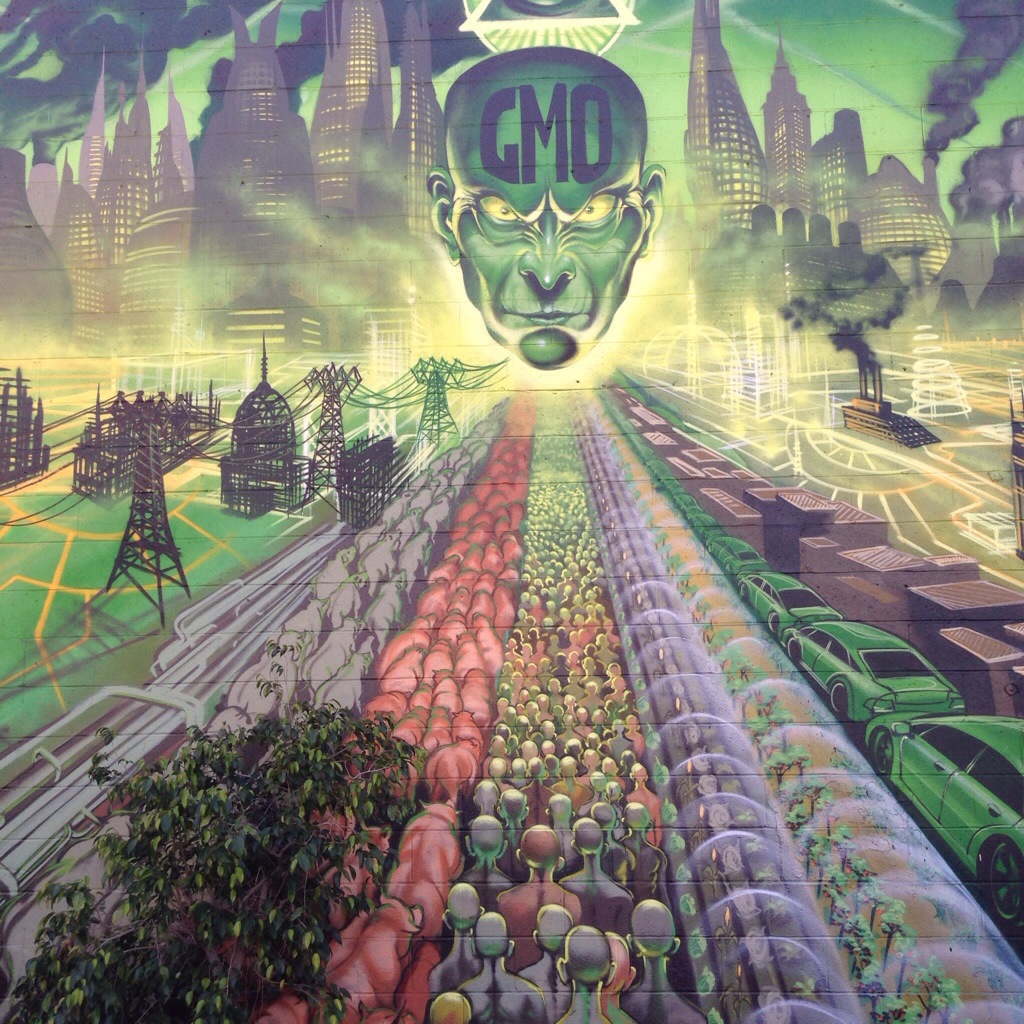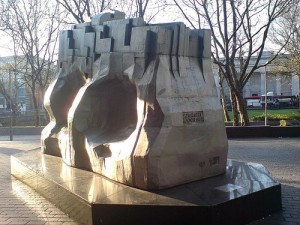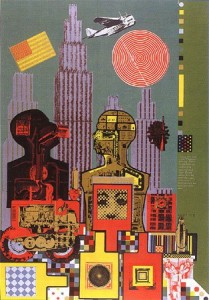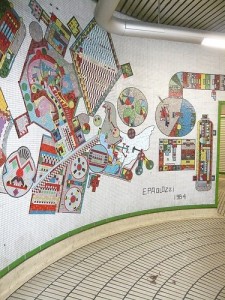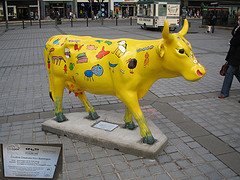Found this wandering around the back lots in Culver City last time I was in LA, a portent of some sorts…
Category: Public art
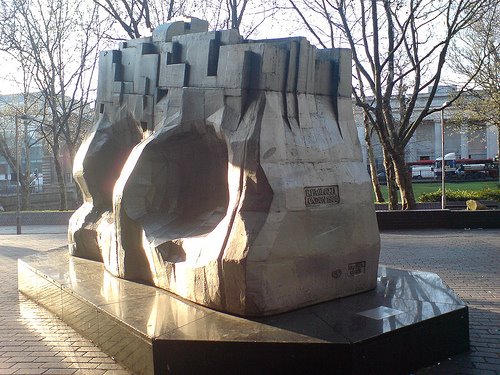
Big Art Mob: Interview with Adam Gee, New Media Commissioner Of Channel 4
On the third anniversary of the death of Sir Eduardo Paolozzi I stood watching a pigeon eyeing up his ‘Piscator’ on the front concourse of Euston station. To the uninitiated, the ‘Piscator’ is the toothy cast iron lump created in homage to the long forgotten expressionist theatre director Edwin Piscator: A giant robo turd wedged between Starbucks, The Cornish Pasty Company and the homeless scots cadging for a return train fare in the squalid and unloved concrete station forecourt.
Paolozzi, a scot with Italian roots, was one of the godfathers of the Pop Art movement. A lecture given by him in 1952 at the ICA in London is widely credited as being the place where the Pop Art bubble was first floated. He was a man, whom, in his own words, enjoyed “Introducing strange fellows to each other in hostile landscapes”. The front concourse at Euston is certainly a hostile landscape and I’ve definitely been called worse than a strange fellow…
Paolozzi was passionate about introducing the man on the street to art. Half monolith maker, half pop artist: An artist that illustrated Henry Ford’s bold assertion that ”History is more or less bunk…. We want to live in the present” early on in his career and yet went on to create timeless hunks of iron.
Paolozzi was also an artist who perfectly encaptures all that was good and bad in 20th century British art: A world class innovator and yet a cosy ambassador of the state. A fine example of an artist as superstar, funded by beaurocrats for the public to stare passively at forever more.
I wondered, what is Paolozzi’s cultural legacy?
Whether or not you are a fan of Paolozzi, it is a compelling argument that the notion of Public Art is in both crisis and at a point of renaissance in Britain today. Perhaps it is the weariness of Brit Art and the arguments surrounding its worthiness, perhaps it’s the success of Anthony Gormely’s ubiquitous mini me’s popping up around Britain like Martello Towers, or his younger hipster brother in arms: Banksey; Dick Turpin meets Tony Hart; man of the people. I.e. Old fashioned showman, popping up on every street corner around the world.
I should be happy, after all, I’m an art lover, but I’m uneasy about Public Art.
I’m unsure of its relevance in an age where the notion of art as a summit of beauty and truth for all is long gone: Why do we feel the need to sponsor an artist’s work in a public domain? To me, it seems almost as if public and private institutions are defending themselves with Public Art in order to obtain certain kudos with their customers or to take the edge of the bitter taste of the reality of the situation: Sweetening the pill in Dead End Street.
It’s time to get off the train.
The fusty rabbit warren that calls its self Tottenham Court Road station holds another Paolozzi piece, a brilliantly colourful mosaic, more than 1000 sq metres in length. I loved this work as a child, I used to try and count the different colours on my way into town on school holidays. Later, in my late teens, on a suburban dosage of acid, the mural would fizz and swirl as the LSD took hold. This mural is a part of me, hard wired into my mind. Later still when I’d learnt about the man who created it, I’d wonder at his creative mind; his obsession with man and machine.
Perhaps it’s not about public versus private, it’s not about institutions or funding, it’s the simple fact: Art improves…
Since I decided to write this piece my senses have been heightened.
Like the LSD wonderland in Tottenham Court Road, suddenly public art has become even more…public, it’s beginning to jump out at me.
The writing is on the wall: Literally. A month almost to the day since I stood pondering the meaning of it all with the pigeons in Euston station, a whooping great contradiction of a show opens at the Tate Modern: Street Art. Its hippy wigs in Woolworths time; surely retrospective rather than celebration? The full turn of the wheel, where revolution becomes a loop. Cultural feedback; the current function of public art?
By now I’m stuck in a loop of my own, needing salvation but with no real prospect of finding any in the bumf churning from the printers of the Art Council publicity machine or any of the myriad of articles written either decrying (‘it’s a shocking waste of public money’) or celebrating (art as cultural / economic / environmental saviour) the current malaise.
It’s not until I stumble upon the Big Art Project that spirits begin to lift. I should have heard about this months ago… Paolozzi would be proud, it’s a mix of pop and grind. It’s a cunning blend of what Channel 4 Television does best; the educational makeover. Jamie’s Dinners, Grand Designs and now… A magic sprinkle of televisual star dust on public art.
I’d stumbled upon the Big Art Project through The Big Art Mob at the Tate Modern (not a troop of vaudevillian gangsters, but an attempt at a fully interactive, mobile phone based, living archive of public art across the British Isles, called rather predictably ‘The Big Art Map’) – You’d think one already existed but, no, (apart from The Wooster Collective, global street art documenters ) it’s taken some wonderfully lateral thinking by Adam Gee, New Media Commissioner, Factual, at Channel 4 Television to bring it all together.
Despite a fairly quiet launch and circumspect nature of the Channel,
Adam Gee and Commissioning Editor Jan Younghusband prove easy to access and are full of passion for the subject and eager to shed further light on the project which has been building for three years in collaboration with The Art Fund and, of course, the Arts Council and is yet to be broadcast as a series (Some point in November is the date given).
Speaking about the ‘Big Art Mob’ Gee relates that the project has allowed him to tie up the various strands of technology at his disposal…
“It’s very much about relaying the whole experience, closing the circle of television, web, mobile and real life. This gives all of us the opportunity to archive public art whilst observing and letting the project go beyond its usual remit in broadcasting”
It’s also allowed Gee to do something that sounds Orwellian ‘Disguise the learning experience’ which basically means to seed participation into the event so that viewers involve themselves in the action. – In the case of the Big Art Mob – taking pictures of art and helping to compile a database.
If Channel 4’s contribution were to stop there it would be an interesting diversion, but where the project really kicks into gear, and what will be the focus of the series, is the entire Big Art Project.
The Big Art project launched in October 2005, the public were asked where and what they’d like to see. Over 1,400 people responded and eventually seven locations were chosen: Burnley, Mull, Newham, North Belfast, Cardigan, St Helens and Sheffield. All are currently in development and when the series it will document the entire process behind the artworks as well as involving the communities that will benefit from the intervention
Younghusband espouses the socio – economic virtues of public art in such poetic terms that I can’t help but mellow.
Both Gee and Younghusband are keen to point out the very close working relationship that they have with The Arts Council and the Art Fund and are full of warmth and praise. I can’t help but feel that the Arts Council must feel a little in awe of the relative glamour that Channel 4 brings to the table and slightly envious of its ability to spice up and cut through, the in house politics of the civil service..
I now realise what my problem was, it was rarely the art that caused real offence, more that my defensive reaction is often caused by not understanding the process and motivations behind something that is supposed to engage me.
It’s not all peachy. Channel 4 has its own version of public art currently on display outside its HQ in Horseferry Road, in Victoria. The Big 4 – why is everything ‘Big’? There’s a whole bag of corporate worms… public art or advertising… it’s advertising. But that’s ok; it’s their cash, their turf.
However, Younghusband sites one inspiration for the Big Art project as being the Cow Parade, the eccentric Swiss public art project that went global. Trouble flared, when The Militant Graffiti Artists of Stockholm took offence at some of the cows which had been painted in corporate colours with advertising slogans.
They kidnapped a fibreglass cow, held power drills to its head and threatened to decapitate it unless the sculptures were declared “non-art.”
They accused the exhibiters of fraud stating that advertisements could never be art, and that…
‘Freedom of expression doesn’t belong to the average person anymore, only to those who have the money to buy a billboard or in this case, a cow that serves the same purpose as a billboard.”
Could this be the real issue with public art? We’ll have to wait and see.
I look forward to seeing Channel 4 work its magic with the Big Art project. No doubt there will be detractors, the inevitable ‘dumbing down’ arguments. But,
I suspect had Paolozzi been around, he would be an advocate, and after all,
the world would be a lesser place without its robo-turds.
